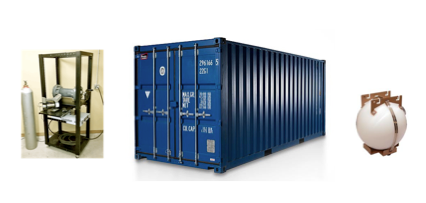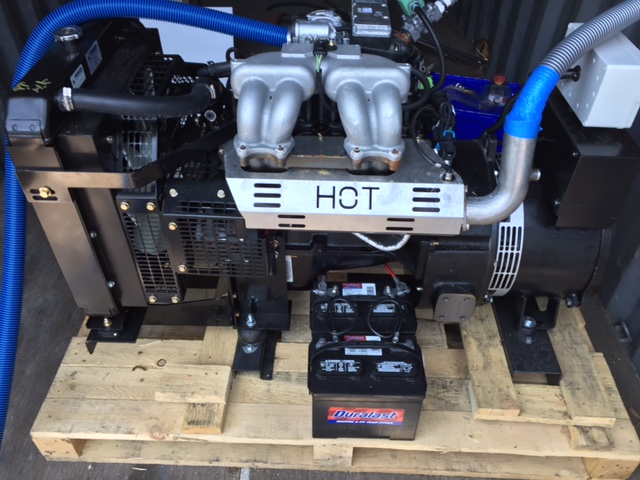TEC Division of Nuclear Instruments (tec-dne)
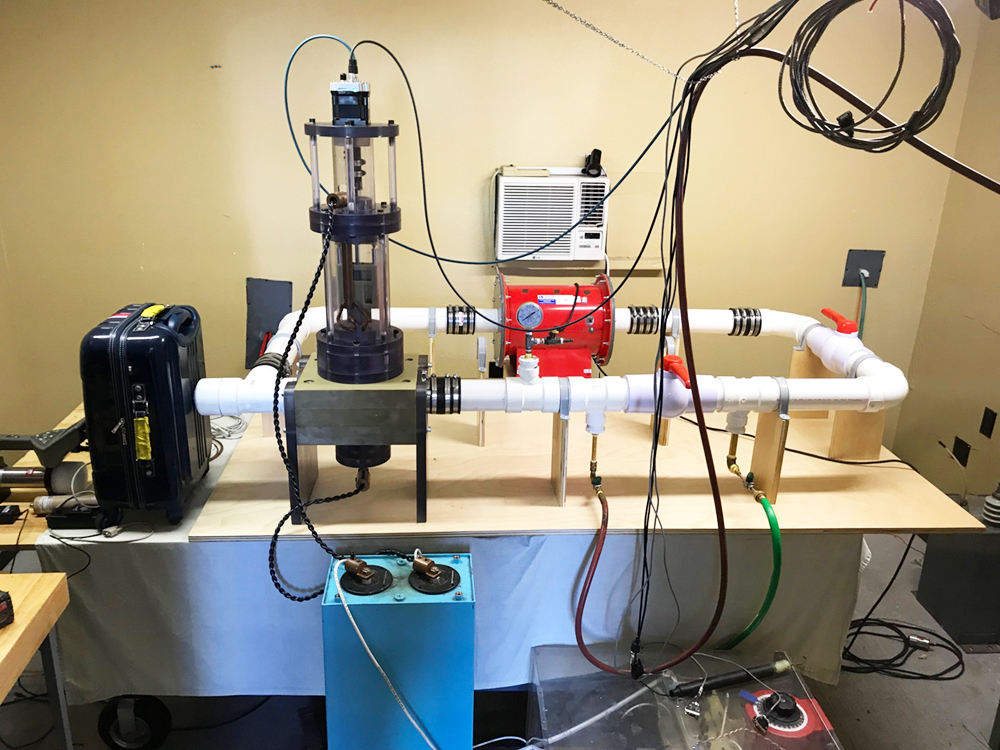
TEC is developing a Directional Neutron Source (TEC-DNS), namely, an equipment capable of producing on demand a flux of neutrons synthesized from the hydrogen with controlled directionality, energy, and counts per seconds. Such an equipment is ideally suited for the detection of nuclear materials that could be concealed in suitcases or container, the detection of precious metals in mining operations and other applications.
For more details, please see the link: http://thunder-energies.com/docs/TEC-DNS-3Za.pdf.
Sample of neutron count per second via the Ludlum model 375 neutron detector: http://thunder-energies.com/docs/DNS3Z.mp4.
DETECTING SMUGGLED NUCLEAR MATERIAL VIA TEC THERMAL NEUTRON SOURCE
1. THE BIGGEST TERRORIST THREAT
A top priority for the security of the United States of America, (as well as of other countries), is to prevent terrorists from smuggling in containers, suitcases or other means, nuclear material suitable for the detonation of an atomic bomb on the our soil.
We are referring to the smuggling of isotopes of uranium, plutonium or other nuclides generally called fissionable nuclear material from their capability to split into smaller nuclei when hit by neutrons, with the release of neurons in numbers bigger than those absorbed, thus triggering a nuclear explosion.
Atomic bombs can be easily decomposed into parts and shipped in different containers, suitcases or other means, and then reassembled on our soil. It is also known that atomic bombs may be available for sale, thus rendering quite real the possibility of their smuggling.

Figure 1. Picture of an atomic explosion
One illustration is is given by the simultaneous detonation underground by Pakistan on May 28, 1998, of five nuclear bombs (known under the code-name of "Chagai-I"). It is known that, due to Pakistan's limited industrial and financial resources, said five nuclear bombs could not possibly have been produced in Pakistan, thus suggesting their origination from another country.
The threat we are facing is compounded by the fact that, due to the failure of existing technologies, at this writing (July 2016), we possess no operational equipment suitable to detect fissionable nuclear material being smuggled in containers, suitcases or other means.
In view of the above, the Founders of Thunder Energies Corporation have spent decades of research and significant private funds for the specific intent of developing a basically new technology capable of detecting nuclear material that could be smuggled in our country, and making said new technology available to the U. S. Government.
Thunder Energies Corporation would like to express its utmost possible appreciation to the U.S. (as well as foreign) Secret Service for preventing the explosion of a nuclear bomb on our soil via the sole use of intelligence and electronic surveillance.
2. PRECEDING FAILED ATTEMPTS
The U. S. Domestic Nuclear Detection Office (DNDO, an agency within the Department of Homeland Security (DHS), has the mission, in collaboration with other domestic and international agencies, of promoting the development of technologies suitable for preventing a terrorist nuclear attack on American soil.
As part of its mission, DNDO has been the target of heavy criticism for its failed programs intended to detect fissionable material called Advanced Spectroscopic Portal Monitor (ASPM) and Cargo Advanced Automated Radiography System (CAARS).
The U.S. Senate Committee on Homeland Security and Governmental Affairs accused DNDO of wasting five years and hundreds of millions of dollars without achieving the intended duty. Since its establishment in 2005, there have been 25 GAO reports plus several independent investigations (American Physical Society, National Academy of Sciences) of DNDO, all of which have been highly critical. There is no reason to believe that our nation is any better protected by the millions spent by DNDO than when it started.
For details and references, please see the ppt http://thunder-energies.com/docs/Detection-fissionable-material.pdf
In view of the above protracted and costly failures, as well as the indicated string criticism from the appropriate Senate Committee, all governmental, programs for the funding of research to develop new technologies for the detection of smuggled fissionable material have been terminated. This illustrates the reason for considerable private investments to date for the development of the needed new technology.
 Figure 2. Illustrations of failed attempts to detect smuggled fissionable material via X-rays and other means.
Figure 2. Illustrations of failed attempts to detect smuggled fissionable material via X-rays and other means.3. THE EFFECTIVE DETECTION OF SMUGGLED FISSIONABLE MATERIAL
The preceding attempts funded by the DNDO, were based on the use of X-rays, particle beams and other radiations. As shown in Figure 1, containers were passed through said radiations and the outcome was analyzed via various detectors.
The failure of these attempts was due to the fact that fissionable materials are stable metals and as such, they appear as ordinary metallic components when scanned via X-rays or particle beams, resulting in the inability to distinguish fissionable material from conventional metallic components.
The only known means for the effective detection of smuggled fissionable materials is via the use of low energy neutrons, called thermal neutrons, because, according to the indicated principles of nuclear bombs, when hit by neutrons, nuclei of fissionable material break down into smaller nuclei while emitting more neutrons than those absorbed.
Therefore, the scanning of containers or suitcases via a beam of thermal neutrons provides the only known effective means to detect smuggled fissionable material, of course, following sufficient investments, appropriate R&D, and governmental approvals, because under the presence of fissionable materials the number of neutrons emitted per second (called neutron Counts Per Seconds - CPS) is bigger than the CPS background, thus establishing the presence of fissionable material.
The main target of TEC Division of Nuclear Equipment (TEC-DNE) is that of developing, under suitable funding and governmental control, Fissionable Material Testing Station (FMTS, see Figure 2) essentially consisting of a remotely controlled Thermal Neutron Source (TEC-TNS) irradiating a container or a suitcase with a low energy neutron flow and the use of a variety of neutron detectors establishing the possible increase of neutron CPS over their background value.
Figure 3. An illustration of the principle of operation of the remotely controlled Fissionable Material Testing Station under development by TEC.
4. THE INDUSTRIAL SYNTHESIS OF NEUTRONS FROM A HYDROGEN GAS,
Neutrons are synthesized in nature from the hydrogen in atom namely, from a proton and an electric the core of stars. As it is well known, stars initiate their life as an aggregate of hydrogen gas. Their density, pressure and temperature increase with the accretion of hydrogen from interstellar spaces to such values for which the hydrogen atom is "compressed" into the neutron according to the original 1909 conception by H. Rutherford.


Figure 4. Stars initiate their life as an aggregate of hydrogen atoms, and must synthesize neutrons before initiating their production of light via nuclear fusions.
TEC Chief Scientist Dr. Ruggero M. Santilli (http://www.santilli-foundation.org/) has dedicated decades of research to achieve a mathematical and theoretical representation of the synthesis of the neutron from the hydrogen atom in the core of a star.
Dr. Santilli initiated his research in the early 1980's when he was in the faculty of Harvard University under DOE grants numbers ER-78-S-02-47420.A000, AS02-78ER04742, DE-AC02-80ER1065, DE-AC02-80ER-1065.A001, and DE-AC02-80ER.1065. The research was then continued at the Institute for Basic Research as well as under other affiliations. The outcome of the research can be found in the Nobel Nomination [1], monograph [2] and lectures [3].
A reason for such an extended research is that quantum mechanics has been constructed for the study of bound states whose mass is smaller than the sum of the masses of the constituents. By contrast, the mass of the neutron is bigger than the sum of the masses of then proton and of the electron, under which conditions the mathematics underlying quantum mechanics is no longer applicable.
Consequently, Dr. Santilli had to construct first a new mathematics, today known as Santilli IsoMathematics, including new numbers, new functional analysis, new differential calculus, new geometries, etc., then construct the corresponding broadening of quantum mechanics, today known as hadronic mechanics, and finally prove their consistency prior to the application of the new formalisms to the synthesis of the neutron.
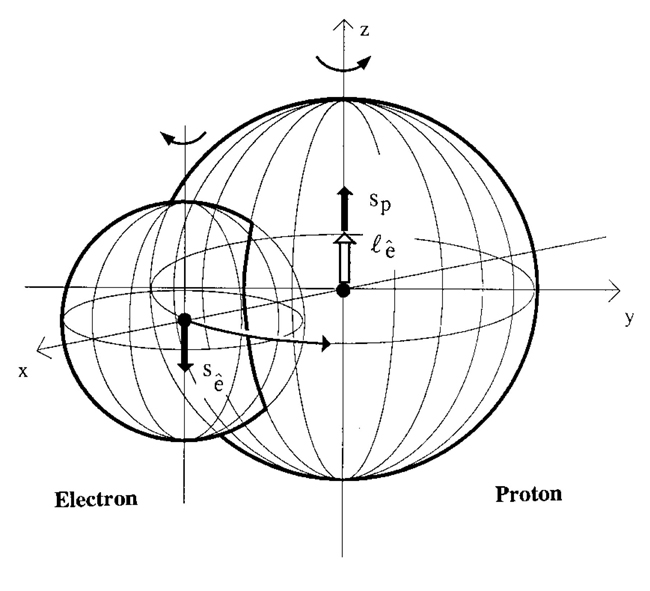
Figure 5. An illustration of the synthesis of the neutron inside a star showing the electron of the hydrogen atom being compressed inside the hyperdense proton. Quantum mechanics could only represent the proton as a point, thus being able to represent the neutron synthesis. Dr. Santilli's novel isomathematics and hadronic mechanics have achieved the first known consistent representation of the proton as an extended particle by allowing a representation of all features of the neutron in its synthesis from the hydrogen [1,2,3].
Following, and only following, the mathematical and theoretical representation of the synthesis of the neutron in the core of stars, Dr. Santilli initiated in the early 2000 experimental research for the industrial synthesis of thermal neutrons from a hydrogen gas via the use of equipment known as hadronic reactors because designed with the mathematics and physics of hadronic mechanics.
The hadronic reactors for the industrial synthesis of thermal neutrons from a hydrogen gas essentially include (TEC international patent pending):
1. A metal vessel filled up with a hydrogen gas at a pressure depending on the desired neutron CPS;
2. Electronic means for the remote control of the gap between a pair of tungsten electrodes located inside said metal vessel; and
3. A specially designed power unit delivering high voltage and high current rapid DC discharges in between said electrodes.
As shown in Figure 5, the DC arc ionizes the hydrogen atoms, thus creating a plasma of protons and electrons; the DC arc then aligns the proton and the electron along a magnetic field line with the appropriate spin and other couplings; an engineering means called triggers compress the electron inside the proton, by supplying the missing energy (which is about one million electron Volts, 1 MeV).
The desired neutron CPS is achieved via the control of the DC rapid discharge as well as by the pressure of the hydrogen gas and other engineering means; neutron production is immediately halted at the shutting off of the DSC arc' and the neutron produced are necessarily thermal due to their neutral character as well as the insufficiency of the DC arc to create high energy neutrons. No explosion can occur in FMTS due to the very low value of neutron CPS sufficient to detect fissionable nuclear material. For technical presentations, please inspect scientific papers [4] to [11] and for independent view please inspect papers [12] to [14] or monograph [15].
Thunder Energies Corporation owns the entirety of the intellectual rights without any royalty payment on the industrial synthesis of neutrons from a hydrogen gas and its use for testing the presence of possible fissionable nuclear material, including the irrevocable ownership of patents, patent applications, copyrights, and know-how.

Figure 6. A partial view of the principle of operation of Dr. Santilli's hadronic reactors for the industrial production of thermal neutrons from a hydrogen gas. The top view indicate the ionization of the hydrogen atom into its constituent proton and electrons with the correct spin alignment. The bottom view indicate the subsequent action of proper 'triggers" for the compression of the electron inside the proton and the supply of the missing 0.783 MeV energy.
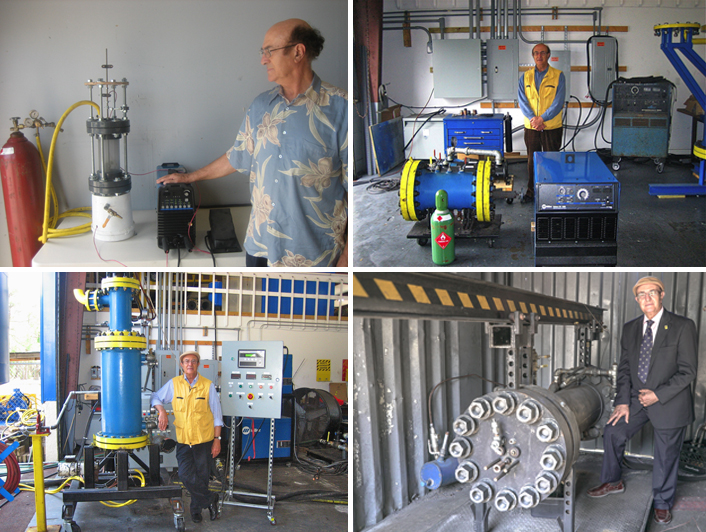 Figure 7. Picture of some of the hadronic reactors built by Dr. Santilli for the industrial synthesis of thermal neutrons from a hydrogen gas, showing from the top left hadronic reactors with 10,, 50, 100 and 300 kW
Figure 7. Picture of some of the hadronic reactors built by Dr. Santilli for the industrial synthesis of thermal neutrons from a hydrogen gas, showing from the top left hadronic reactors with 10,, 50, 100 and 300 kW
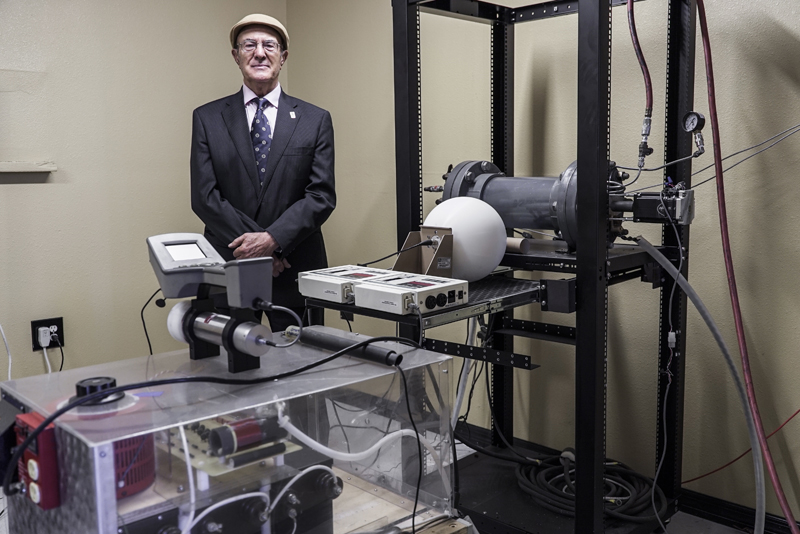 Figure 8. A view of the first prototype of the Thermal Neutron Source (TEC-TNS) built by Dr. Santilli following the data gathered from the preceding tests.
Figure 8. A view of the first prototype of the Thermal Neutron Source (TEC-TNS) built by Dr. Santilli following the data gathered from the preceding tests.
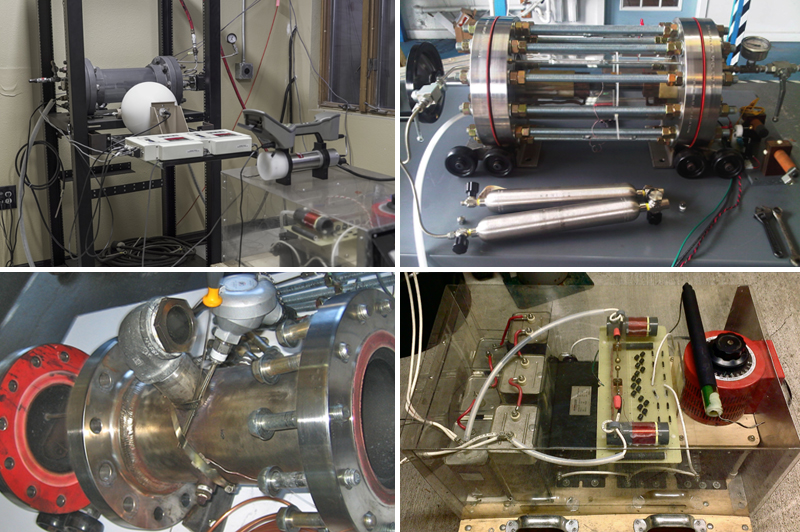
Figure 9. Pictures of main components of TEC-TNS including from the top left: a close-up of the hadronic reactor with a Ludlum and Berkeley Nucleonics neutron detectors; two alternative versions of the hadronic reactors; and the specially designed pulsing power unit.
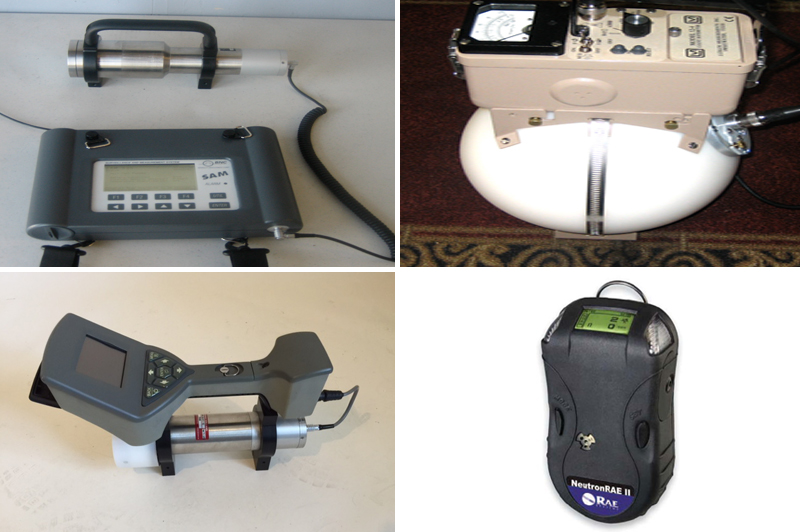
Figure 10. Pictures of some of the neutron detectors used by Dr. Santilli in the above indicated tests, including from the top left: Berkeley Nucleonics SAM 034; Ludlum; DSAM 940; and Polimaster (for technical details, please visit the website [11]).
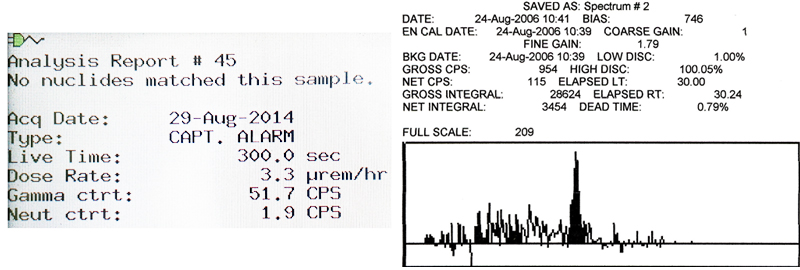

Figure 11. Samples of neutron detections in the indicated tests, including from the top left: detection of neutron CPS; detection of gammas; and two alarms due to continuous neutron detection (for tecxhnical details, please visit website [11]).
Figure 12. Picture of the new generation of TEC-TNS currently under testing (July 2016). See DVD [11] for details.
5. FORWARD LOOKING
Thunder Energies Corporation intends to secure governmental funds from the applicable division of our Homeland Security for the construction of an operational prototype of the Fissionable Material Testing Station (TEC-FMTS) based on the use of the TEC-TNS and a variety of neutron detections.
In order to achieve this goal, Thunder Energies Corporation is actively seeking a partner with a federally approved nuclear laboratory as well as with the necessary qualification to receive federal research grants.
Jointly, Thunder Energies Corporation has been soliciting nuclear physics laboratory for an independent confirmation of Dr. Santilli's laboratory synthesis of the neutron from a hydrogen gas.
Scientific publications in refereed journals are reported in the archive
http://www.santilli-foundation.org/news.html while industrially relevant advances are reported in the news section
http://www.thunder-energies.com/index.php/ct-menu-item-13
REFERENCES
[1] J. Feldman, "Open Nomination of Prof. R. M. Santilli for the Nobel Prize in Physics." July 2016,
TO BE IDENTIFIED http://nobelprizeweb.com/
[2] R. M. Santilli, The Physics of New Clean Energies and Fuels According to Hadronic Mechanics, Special issue of the Journal of New Energy, 318 pages (1998)
http://www.santilli-foundation.org/docs/Santilli-114.pdf
[3] R. M. Santilli, Lectures, IsoLinear IsoInvariant isoRelativity,
I. Limitations of Special Relativity and Quantum Mechanics
http://www.world-lecture-series.org/isorelativity-2014-i
II. Experimental Verifications in Particle Physics
http://www.world-lecture-series.org/isorelativity-2014-ii
III. Verifications in Nuclear Physics
http://www.world-lecture-series.org/isorelativity-2014-iii
[4] R. M. Santilli, Confirmation of Don Borghi's experiment on the synthesis of neutrons, arXiv publication, August 15, 2006
http://arxiv.org/pdf/physics/0608229v1.pdf
[5] R. M. Santilli, The synthesis of the neutron according to hadronic mechanics and chemistry,” Journal Applied Sciences 5 Vol.5, 32 (2006)
[6] R. M. Santilli, ”Apparent confirmation of Don Borghis experiment on the laboratory synthesis of neutrons from protons and electrons, Hadronic J. 30, 29 (2007)
http://www.i-b-r.org/NeutronSynthesis.pdf
[7] R. M. Santilli, "The synthesis of the neutron from the hydrogen" website
http://www.neutronstructure.org/
[8] R. M. Santilli, ”Documentation of scans from the Polimaster and SAM 935 detectors during tests [11-13] http://www.neutronstructure.org/neutron-synthesis-2.
http://www.neutronstructure.org/neutron-synthesis-2.htm
[9] R. M. Santilli and A. Nas, "Confirmation of the Laboratory Synthesis of Neutrons from a Hydrogen Gas," Journal of Computational Methods in Sciences and Engiineering Vol. 14 (2014), 405–414,)
www.thunder-energies.com/docs/neutron-synthesis-2014.pdf
[10] R. M. Santilli, "A 2016 DVD on the Laboratory Synthesis of Neutrons from a Hydrogen Gas”
http://www.world-lecture-series.org/newtron-synthesis-08-14
[11] Chandrakant S. Burande, "On the experimental verification of the Rutherford-Santilli neutron," American Institute of Physics 1558, 693 (2013); doi: 10.1063/1e
http://www.santilli-foundation.org/docs/Burande-2.pdf
[12] Chandrakant S. Burande, "Santilli Synthesis of the Neutron According to Hadronic Mechanics,' American Journal of Modern Physics 2016; 5(2-1): 17-36
http://www.santilli-foundation.org/docs/pdf3.pdf
[13] J. V. Kadeisvili, :The Rutherford-Santilli Neutron," Hadronic J. Vol. 31, pages 1-125, 2008, pdf version of the published paper
http://www.i-b-r.org/Rutherford-Santilli-II.pdf
also available in htlm format at
http://www.i-b-r.org/Rutherford-Santilli-neutron.htm
[14] I. Gandzha and J Kadeisvili, New Sciences for a New Era: Mathematical, Physical and Chemical Discoveries of Ruggero Maria Santilli, Sankata Printing Press, Nepal (2011)
http://www.santilli-foundation.org/docs/RMS.pdf
RECENT EXPERIMENTAL CONFIRMATION OF THE SYNTHESIS OF THE NEUTRON FROM THE HYDROGEN
"Experimental Confirmation of the Synthesis of Neutrons and Neutroids from a Hydrogen Gas"
By: Richard Norman, Anil A. Bhalekar, Simone Beghella Bartoli,
Brian Buckley, Jeremy Dunning-Davies, Jan Rak, Ruggero M. Santilli
American Journal of Modern Physics, 6(4-1): 85-104 (2017)
http://www.santilli-foundation.org/docs/confirmation-neutron-synthesis-2017.pdf
You can have an idea of the operation from the short films:
Two minute minute movie of TEC neutron source in operation
http://thunder-energies.com/docs/MagnaPower.mp4 ;
neutron counts per Seconds detected by the Ludlum detector model 375
http://thunder-energies.com/docs/Ludlum-Alarms.mp4 ;
confirmation of such detection by the Berkeley Nucleonics SAM 940
http://thunder-energies.com/docs/Sam-Alarms.mp4 ;
and confirmation of neutron detection by the Russian detector Polimaster model PM1704
http://thunder-energies.com/docs/polimaster-reading.pdf
